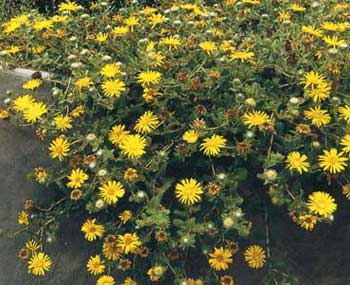Contents:
Common Names | Parts Usually Used | Plant(s) & Culture | Where Found | Medicinal Properties | Biochemical Information
Legends, Myths and Stories | Uses | Formulas or Dosages | Warning | Bibliography
Scientific Names

- Grindelia squarrosa L.
- Compositae
- Composite family
Common Names
- August flower
- Gumweed
- Resin-weed
- Sticky heads
- Tarweed
Parts Usually Used
Leaves, flowering tops
Back to Top
Description of Plant(s) and
Culture
Gum plant is a bushy biennial or perennial plant; several stems grow together to a height of 1-2 feet and bear alternate, oblong to ovate or lanceolate, sharply serrate or denticulate (the uppermost may be entire), leathery leaves. It has many leafy branches and many flower heads. Two to five yellow flower heads, about an inch across, grow in a terminal cyme; they are sticky and the bracts which surround them are rolled back; from August to September. Flowers of aromatic taste and balsamic odor.
Back to Top
Where Found
Native to, but not plentiful in, the coastal areas of California. Found in open and dry areas, on roadsides and waste land and often a weed of rangeland. British Columbia to Minnesota and south to California and Texas.
Back to Top
Medicinal Properties
Antispasmodic, demulcent, diaphoretic, expectorant, sedative
Back to Top
Biochemical Information
Up to 21% amorphous resins, tannin, laevoglucose and volatile oils
Back to Top
Legends, Myths and Stories
The Shoshone Indians called the gum plant (Grindelia squarrosa) by the name of “Sanaka para” and the Blackfeet Indians called it “Aks-Peis.”
They used it as a cough medicine; using the upper 1/3 of the plant dried, especially the sticky buds. This was also taken for dropsy and smallpox. The boiled root was taken as a tea internally.
Back to Top
Uses
Used in small doses, gum plant helps colds, nasal congestion, bronchial irritation, and for the spasms of whooping cough and asthma. Has been used to treat catarrhal kidney problems, iritis, indigestion, and cystitis. Externally, the tea is used as a wash for burns, rashes, blisters, and inflammations; a fluid extract, diluted with 6 to 10 parts water, can be applied to skin irritation caused by poison ivy or poison oak (soak a clean bandage, keep it moist, and change often). Used in external ulcers, impetigo, eczema and allergic dermatitis. Native Americans used the buds on the plant, dried they were used for smallpox and measles, toothache, rheumatism.
Back to Top
Formulas or Dosages
Use dried leaves or flowering tops.
Infusion: steep 1 tsp. dried leaves or flowering tops in 1 cup boiling water. Take 1 cup a day.
Tincture of Grindelia: take 5-30 drops, as required.
Back to Top
Warning
Gum plant tends to take up selenium compounds (a sulphur-like non-metallic element) from the soil and store them. It becomes toxic in areas where the soil is rich in selenium; do not pick it from such areas. Large doses can be poisonous; smaller doses may cause slowing of the heartbeat. Avoid in cases of low blood pressure.
Because of its high resin content, it is considered hard on the kidneys and for this reason usually is used only for acute ailments.
Back to Top
Bibliography
![]() Back to Eden
Back to Eden, by Jethro Kloss; Back to Eden Publishing Co., Loma Linda, CA 92354, Original copyright 1939, revised edition 1994
![]() The Herb Book
The Herb Book, by John Lust, Bantam Books, 666 Fifth Avenue, New York, NY. copyright 1974.
![]() Eastern/Central Medicinal Plants
Eastern/Central Medicinal Plants, by Steven Foster and James A. Duke., Houghton Mifflin Company, 215 Park Avenue South, New York, NY 10000
![]() Planetary Herbology
Planetary Herbology, by Michael Tierra, C.A., N.D., O.M.D., Lotus Press, PO Box 325, Twin Lakes. WI 53181., Copyright 1988, published 1992
![]() The Complete Medicinal Herbal
The Complete Medicinal Herbal, by Penelope Ody, Dorling Kindersley, Inc, 232 Madison Avenue, New York, NY 10016, First American Edition, copyright 1993
![]() Indian Herbalogy of North America
Indian Herbalogy of North America, by Alma R. Hutchens, Shambala Publications, Inc., Horticultural Hall, 300 Massachusetts Avenue, Boston, Massachusetts 02115, 1973
![]() American Folk Medicine
American Folk Medicine, by Clarence Meyer, Meyerbooks, publisher, PO Box 427, Glenwood, Illinois 60425, 1973
![]() Indian Uses of Native Plants
Indian Uses of Native Plants, by Edith Van Allen Murphey, Meyerbooks, publisher, PO Box 427, Glenwood, Illinois 60425, copyright 1958, print 1990
![]() Webster’s New World Dictionary
Webster’s New World Dictionary, Third College Edition, Victoria Neufeldt, Editor in Chief, New World Dictionaries: A Division of Simon & Schuster, Inc., 15 Columbus Circle, New York, NY 10023
 An Instant Guide to Medicinal Plants
An Instant Guide to Medicinal Plants, by Pamela Forey and Ruth Lindsay, Crescent Books (January 27, 1992).
![]() The Yoga of Herbs: An Ayurvedic Guide to Herbal Medicine
The Yoga of Herbs: An Ayurvedic Guide to Herbal Medicine, by Dr. David Frawley & Dr. Vasant Lad, Lotus Press, Twin Lakes, Wisconsin, Second edition, 1988.
 The Rodale Herb Book: How to Use, Grow, and Buy Nature’s Miracle Plants (An Organic gardening and farming book)
The Rodale Herb Book: How to Use, Grow, and Buy Nature’s Miracle Plants (An Organic gardening and farming book), edited by William H. Hylton, Rodale Press, Inc. Emmaus, PA, 18049., 1974
